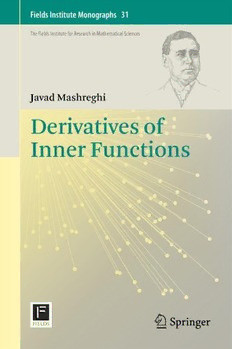
Derivatives of Inner Functions PDF
Preview Derivatives of Inner Functions
Fields Institute Monographs VOLUME 31 The Fields Institute for Research in Mathematical Sciences FieldsInstituteEditorialBoard: CarlR.Riehm,ManagingEditor EdwardBierstone,DirectoroftheInstitute MatheusGrasselli,DeputyDirectoroftheInstitute JamesG.Arthur,UniversityofToronto KennethR.Davidson,UniversityofWaterloo LisaJeffrey,UniversityofToronto BarbaraLeeKeyfitz,OhioStateUniversity ThomasS.Salisbury,YorkUniversity NorikoYui,Queen’sUniversity TheFieldsInstituteisacentreforresearchinthemathematicalsciences,locatedin Toronto,Canada.TheInstitutesmissionistoadvanceglobalmathematicalactivity intheareasofresearch,educationandinnovation.TheFieldsInstituteissupported bytheOntarioMinistryofTraining,CollegesandUniversities,theNaturalSciences and Engineering Research Council of Canada, and seven Principal Sponsoring Universities in Ontario (Carleton, McMaster, Ottawa, Toronto, Waterloo, Western andYork),aswellasbyagrowinglistofAffiliateUniversitiesinCanada,theU.S. andEurope,andseveralcommercialandindustrialpartners. Forfurthervolumes: http://www.springer.com/series/10502 Javad Mashreghi Derivatives of Inner Functions 123 TheFieldsInstituteforResearch intheMathematicalSciences JavadMashreghi De´partementdemathe´matiquesetde statistique Universite´Laval Que´bec,QC Canada ISSN1069-5273 ISSN2194-3079(electronic) ISBN978-1-4614-5610-0 ISBN978-1-4614-5611-7(eBook) DOI10.1007/978-1-4614-5611-7 SpringerNewYorkHeidelbergDordrechtLondon LibraryofCongressControlNumber:2012947407 MathematicsSubjectClassification(2010):30D50,30D40,30D55,30E20,30E25,32A36 ©SpringerScience+BusinessMediaNewYork2013 Thisworkissubjecttocopyright.AllrightsarereservedbythePublisher,whetherthewholeorpartof thematerialisconcerned,specificallytherightsoftranslation,reprinting,reuseofillustrations,recitation, broadcasting,reproductiononmicrofilmsorinanyotherphysicalway,andtransmissionorinformation storageandretrieval,electronicadaptation,computersoftware,orbysimilarordissimilarmethodology nowknownorhereafterdeveloped.Exemptedfromthislegalreservationarebriefexcerptsinconnection with reviews or scholarly analysis or material supplied specifically for the purpose of being entered and executed on a computer system, for exclusive use by the purchaser of the work. Duplication of this publication or parts thereof is permitted only under the provisions of the Copyright Law of the Publisher’slocation,initscurrentversion,andpermissionforusemustalwaysbeobtainedfromSpringer. PermissionsforusemaybeobtainedthroughRightsLinkattheCopyrightClearanceCenter.Violations areliabletoprosecutionundertherespectiveCopyrightLaw. Theuseofgeneraldescriptivenames,registerednames,trademarks,servicemarks,etc.inthispublication doesnotimply,evenintheabsenceofaspecificstatement,thatsuchnamesareexemptfromtherelevant protectivelawsandregulationsandthereforefreeforgeneraluse. Whiletheadviceandinformationinthisbookarebelievedtobetrueandaccurateatthedateofpub- lication,neithertheauthorsnortheeditorsnorthepublishercanacceptanylegalresponsibilityforany errorsoromissionsthatmaybemade.Thepublishermakesnowarranty,expressorimplied,withrespect tothematerialcontainedherein. Coverillustration:DrawingofJ.C.FieldsbyKeithYeomans Printedonacid-freepaper SpringerispartofSpringerScience+BusinessMedia(www.springer.com) Ouvrez une ´ecole, vous fermerez une prison Victor Hugo It was in 1934 that Pahlavi High School was established in my hometown, Kashan. In 1946, the school moved to a new building constructed over a rather vast area and featuring an awesome architectural design. The school was renamed Imam Khomeini High School after the 1979 revolution. Over the years, numerous bright minds were trained in the stimulating environ- mentofthisschool.Beforelong,theimpressiveschoolbuildinghadbecomea reminderofallthegreatintellectualswhohadeitherstudiedortaughtthere. To the utter regret of the latter, however, the building was completely de- molishedin 1995,only to giveway to the current, incomplete one. I dedicate this monographto all the caring and respectedmen, teachersand employees alike,whokeptthe flame ofeducationalightformanyyearsinthis institute. Preface Infinite Blaschke products were introduced by W. Blaschke in 1915 [9]. In 1929,R. Nevanlinna introducedthe class ofbounded analytic functions with almost everywhere unimodular boundary values [35]. However, the term in- nerfunction wascoinedmuchlaterbyA.Beurlinginhisseminalworkonthe invariantsubspacesoftheshiftoperator[8].Thefirstextensivestudiesofthe properties of inner functions were made by O. Frostman [22], W. Seidel [43] andF.Riesz[40].Theireffortstounderstandthe zerosandboundarybehav- iorofboundedanalyticfunctionsledtothecelebratedcanonicalfactorization theorem. The special factorization that we need says that each inner func- tion is the product of a Blaschke product and a zero free inner function, the so called singular inner function, which is generated by a singular measure residing on the unit circle. Roughly speaking, we can say that the Blaschke product is formed with the zeros of an inner function inside the open unit disc, and the singular part stems from its zeros on the boundary. InJuly2011,E.FricainandIorganizedaconferenceonBlaschke products and their applications in the Fields Institute (Toronto). There were several interesting talks about the boundary behavior of inner functions, in partic- ular Blaschke products, and their derivatives. I felt the need to gather some classical results in a short monograph for graduate students and as a handy reference for experts. However, the literature is very vast and it is a difficult task to choose among various important results. For example, the book of P. Colwell [16] can provide a panoramic picture of this subject. Hence, I re- strictedmyselfjusttotheintegralmeansofthe derivativesand,evenforthis narrow subject, I was very selective. The Fields Institute exclusively supported our conference on Blaschke products, and its direction constantly helped us for the production of the proceedings and this monograph. In particular, I owe profound thanks to CarlRiehm,theManagingEditorofPublications,forhiscare,guidance,and enthusiastic support. Last but not the least, I would like to deeply thank vii viii Preface Joseph Cima (University of North Carolina), Ian Graham (University of Toronto), and Armen Edigarian (Jagiellonian University) who kindly read the manuscript and made many valuable suggestions. Their remarks enor- mously improved the quality of text. Montreal, QC Javad Mashreghi Contents 1 Inner Functions........................................... 1 1.1 The Poisson Integral of a Measure ........................ 1 1.2 The Hardy Space Hp(D) ................................ 6 1.3 Two Classes of Inner Functions........................... 8 1.4 The Canonical Factorization ............................. 12 1.5 A Characterizationof Blaschke Products .................. 17 1.6 The Nevanlinna Class N and Its Subclass N+ ............. 20 1.7 Bergman Spaces........................................ 23 2 The Exceptional Set of an Inner Function ................ 27 2.1 Frostman Shifts and the Exceptional Set E ................ 27 ϕ 2.2 Capacity .............................................. 30 2.3 Hausdorff Dimension.................................... 32 2.4 E Has Logarithmic Capacity Zero........................ 35 ϕ 2.5 The Cluster Set at a Boundary Point ..................... 37 3 The Derivative of Finite Blaschke Products............... 39 3.1 Elementary Formulas for B(cid:2) ............................. 39 3.2 The Cardinality of the Zeros of B(cid:2) ........................ 40 3.3 A Formula for |B(cid:2)|...................................... 42 3.4 The Locus of the Zeros of B(cid:2) in D ........................ 46 3.5 B Has a Nonzero Residue ............................... 48 4 Angular Derivative ....................................... 51 4.1 Elementary Formulas for B(cid:2) and S(cid:2) ....................... 51 4.2 Some Estimations for Hp-Means.......................... 54 4.3 Some Estimations for Ap-Means.......................... 57 4.4 The Angular Derivative ................................. 60 4.5 The Carath´eodory Derivative ............................ 62 4.6 Another Characterizationof the Carath´eodoryDerivative.... 68 ix
